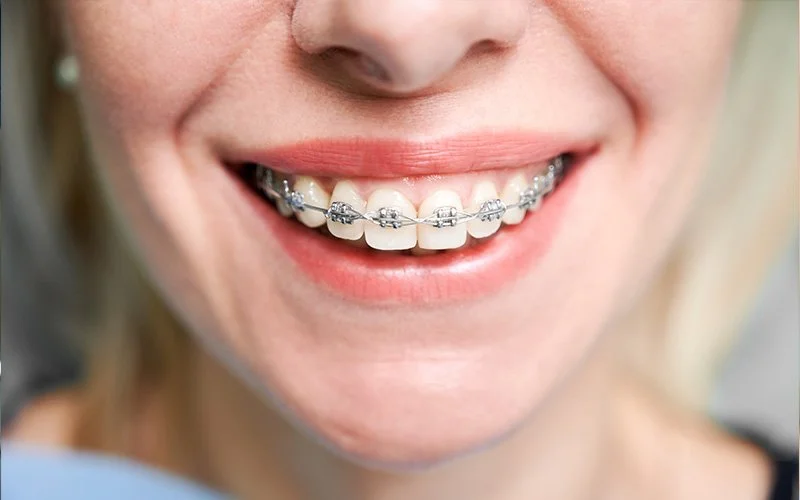How Orthodontic Treatment Can Help Gummy Smiles
Key Takeaways
A gummy smile refers to the excessive display of upper gum tissue when smiling, which can be caused by factors such as tooth position, jaw structure, or lip movement.
Orthodontic treatments, such as braces, Invisalign, and Temporary Anchorage Devices (TADs), may help reduce gum visibility by adjusting tooth alignment and bite.
In some cases, orthodontic treatments alone may not be sufficient. Additional treatments like jaw surgery, gingival contouring, or botulinum toxin injections may be considered.
Understanding Gummy Smiles: Causes and Treatment Options
Do you have a gummy smile? This is a condition that occurs when a significant portion of the upper gum tissue is visible when smiling. While not a medical concern in most cases, it can influence how someone feels about their appearance.
Orthodontic treatment offers several options to address this issue by adjusting the position of the teeth and bite alignment. In this article, we examine the different orthodontic solutions for gummy smiles, the use of Temporary Anchorage Devices (TADs), and situations where additional intervention may be required.
Exploring Orthodontic Solutions for Gummy Smiles
1. Braces: Shifting Teeth to Address Proportions
In cases where the gummy appearance is related to dental misalignment, adjusting the position of the upper teeth may lead to a more balanced gum-to-tooth ratio. This is where conventional braces may be used to reposition the teeth and support bite alignment, potentially reducing the vertical height of the smile. Though not a guaranteed fix for every case, braces are often the first step in the treatment process.
However, some individuals, particularly working adults, may find traditional metal braces less appealing due to their visibility and impact on daily appearance. For these patients, discreet options like self-ligating braces with ceramic brackets may offer a more subtle alternative while still addressing the alignment issues contributing to a gummy appearance.
2. Invisalign: Another Discreet Alternative
Clear aligners are another discreet option for those who prefer to avoid traditional metal braces. Like braces, these custom-made trays gradually shift teeth into their proper positions, which may help reduce the appearance of a gummy smile. One practical advantage is that aligners can be removed during meals or oral hygiene routines, which can be appealing to many adults and teenagers.
3. Temporary Anchorage Devices (TADs): Targeted and Controlled Movement
In more complex cases, TADs may be used to facilitate controlled tooth movement. These are small, screw-like implants that may be used as anchorage to move the upper front teeth upward, helping to reduce excessive gum display when smiling.
TADs are commonly used in combination with braces or other orthodontic methods to help intrude over-erupted teeth or adjust vertical tooth positioning. Their use is typically short-term and determined based on the individual’s needs and treatment goals.
When Orthodontics Alone Isn’t Enough
At the same time, it is important to understand that issues with gum visibility may not always be corrected through orthodontics alone. In some individuals, the condition may be related to factors beyond tooth alignment, such as:
Skeletal variations, like a high upper jaw or vertical maxillary excess
Excess gum tissue, which creates an uneven balance between the gums and teeth
Elevated lip movement, where the upper lip lifts higher than usual when smiling
In such situations, additional interventions may be considered alongside orthodontic care, including:
Jaw surgery: To adjust the position of the upper jaw
Gingival contouring: To reduce and reshape excess gum tissue
Botulinum toxin (Botox): To temporarily limit upper lip elevation during smiling.
These approaches aim to address the root causes that braces or aligners may not be able to correct on their own.
Finding the Right Treatment for Gummy Smiles
In conclusion, orthodontic treatment can contribute to reducing the appearance of a gummy smile, especially when tooth position or bite alignment plays a role. Options such as traditional braces, self-ligating braces, Invisalign, and Temporary Anchorage Devices (TADs) may be considered, depending on the individual’s needs and clinical assessment.
However, every case is different. A thorough evaluation is important to determine whether orthodontics alone is suitable or if a combined approach may be more appropriate. If you're exploring treatments for smile correction, Align Braces Clinic is here to help. Our team will conduct a detailed consultation and guide you through the available options based on your condition and goals.
Book an appointment with us today.



